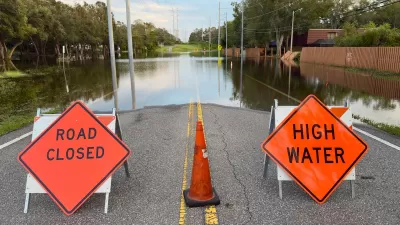Housing market pressures, flood insurance costs, changing FEMA maps, and improved methods of flood control are giving victims of flood damage in Louisiana mixed signals on how high they should rebuild their homes.

As Baton Rouge dries out from its record flooding, homeowners will have a tough choice to make as they seek to rebuild. How high will they need to elevate their homes to avoid future flooding that is becoming more commonplace? David Mitchell of The Advocate reports that a variety of changes in flood insurance requirements, flood maps, and improvements in flood control are giving homeowners less incentive to raise the height of their homes, as was seen across the city of New Orleans following Hurricane Katrina.
Area leaders around Baton Rouge already have an eye on easing the path to return. Baton Rouge and Ascension officials in recent weeks moved to loosen parish rules that had been tighter than FEMA minimum standards, set that way years ago to reap the benefit of lower flood insurance rates.
They have already eliminated requirements that homeowners build to the “record inundation,” an as yet unknown height that local officials feared could be even higher and more expensive than that required for base flood elevations.
Just last week the Metro Council in East Baton Rouge also shifted elevation requirements to the FEMA minimum by eliminating a city-parish rule that would have required some flooded properties in locations not deemed to be at highest risk to elevate. The change spares 32,000 flooded homes -- an estimated half of those that flooded in the parish -- from a possible elevation requirement.
The cost for homeowners to elevate their homes to the base flood elevation has proven costly—forcing homeowners to tear down their existing, damaged homes and just rebuild rather than elevate the existing structures. In New Orleans, a program to provide grants to homeowners to help elevate their homes has largely been sidelined, in favor of a more comprehensive response to contain and prevent future flooding.
FULL STORY: After Katrina, house elevations in New Orleans depended on timing, funding, mindset

Study: Maui’s Plan to Convert Vacation Rentals to Long-Term Housing Could Cause Nearly $1 Billion Economic Loss
The plan would reduce visitor accommodation by 25,% resulting in 1,900 jobs lost.

North Texas Transit Leaders Tout Benefits of TOD for Growing Region
At a summit focused on transit-oriented development, policymakers discussed how North Texas’ expanded light rail system can serve as a tool for economic growth.

Why Should We Subsidize Public Transportation?
Many public transit agencies face financial stress due to rising costs, declining fare revenue, and declining subsidies. Transit advocates must provide a strong business case for increasing public transit funding.

How to Make US Trains Faster
Changes to boarding platforms and a switch to electric trains could improve U.S. passenger rail service without the added cost of high-speed rail.

Columbia’s Revitalized ‘Loop’ Is a Hub for Local Entrepreneurs
A focus on small businesses is helping a commercial corridor in Columbia, Missouri thrive.

Invasive Insect Threatens Minnesota’s Ash Forests
The Emerald Ash Borer is a rapidly spreading invasive pest threatening Minnesota’s ash trees, and homeowners are encouraged to plant diverse replacement species, avoid moving ash firewood, and monitor for signs of infestation.
Urban Design for Planners 1: Software Tools
This six-course series explores essential urban design concepts using open source software and equips planners with the tools they need to participate fully in the urban design process.
Planning for Universal Design
Learn the tools for implementing Universal Design in planning regulations.
City of Santa Clarita
Ascent Environmental
Institute for Housing and Urban Development Studies (IHS)
City of Grandview
Harvard GSD Executive Education
Toledo-Lucas County Plan Commissions
Salt Lake City
NYU Wagner Graduate School of Public Service





























